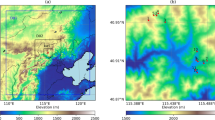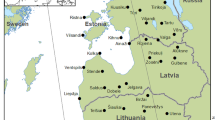Abstract
Vertically exploring the characteristics of the typhoon boundary layer (TBL) plays an important role in recognizing typhoon structure. The boundary layer radial direction and tangential wind characteristics of Typhoon Usagi based on the observational data of three boundary layer wind profiler stations along the route of Typhoon Usagi (No. 1319) and by combining with sounding data. The results show that: (1) maximum tangential wind appears in the vicinity of the eye area of Usagi, and it basically maintains a height of around 1 800 m when Usagi keeps a strong typhoon level, with the rapidly decreasing strength of Usagi after it lands, the speed of the maximum tangential wind and its vertical range both decrease; (2) the height of the maximum tangential wind is close to that of the inflow layer top of the typhoon, and is greater than that of the boundary layer estimated on the basis of Richardson number or potential temperature gradient, while the height of mixed layer judged on the basis of the signal-to-noise ratio (SNR) or its gradient is usually low; (3) the the boundary layer height can reach higher than 2 100 m before Usagi lands. When the typhoon level or above is achieved, the boundary layer height observed by various stations does not change much, basically staying at between 1 200 and 1 600 m. With the decreasing strength of Usagi after its landfall, the boundary layer height rapidly drops.
Similar content being viewed by others
References
Angevine W M, White A B, Avery S K. 1994. Boundary-layer depth and entrainment zone characterization with a boundary-layer profiler. Boundary-Layer Meteorology, 68(4): 375–385
Dai C, Wang Q, Kalogiros J A, et al. 2014. Determining boundary-layer height from aircraft measurements. Boundary-Layer Meteorology, 152(3): 277–302
Emanuel K A. 1986. An air-sea interaction theory for tropical cyclones. Part I: steady-state maintenance. Journal of the Atmospheric Sciences, 43(6): 585–605
Franklin J L, Black M L, Valde K. 2003. GPS dropwindsonde wind profiles in hurricanes and their operational implications. Weather and Forecasting, 18(1): 32–44
Kepert J D. 2006. Observed boundary layer wind structure and balance in the hurricane core. Part I: hurricane Georges. Journal of the Atmospheric Sciences, 63(9): 2169–2193
Kepert J D. 2012. Choosing a boundary layer parameterization for tropical cyclone modeling. Monthly Weather Review, 140(5): 1427–1445
Kepert J D. 2013. How does the boundary layer contribute to eyewall replacement cycles in axisymmetric tropical cyclones?. Journal of the Atmospheric Sciences, 70(9): 2808–2830
Kepert J D, Schwendike J, Ramsay H. 2016. Why is the tropical cyclone boundary layer not “well mixed”?. Journal of the Atmospheric Sciences, 73(3): 957–973
Li Yubin, Cheung K K W, Chan J C L. 2015. Modelling the effects of land-sea contrast on tropical cyclone precipitation under environmental vertical wind shear. Quarterly Journal of the Royal Meteorological Society, 141(687): 396–412
Liao Fei, Deng Hua, Hou Ling. 2016. Quality analysis and process of wind profiler data on rain condition. Journal of Tropical Meteorology (in Chinese), 32(5): 588–596
Ma Leiming, Bao Xuwei. 2016. Parametrization of planetary boundary-layer height with helicity and verification with tropical cyclone prediction. Boundary-Layer Meteorology, 160(3): 569–593
Ma hongyun, Ma Jingxian, Luo Zhexian. 2003. Effects of tangential wind profile on typhoon’s track and intensity. Journal of Nanjing Institute of Meteorology (in Chinese), 26(6): 780–787
Moss M S. 1978. Low-level turbulence structure in the vicinity of a hurricane. Monthly Weather Review, 106(6): 841–849
Moss M S, Merceret F J. 1976. A note on several low-layer features of Hurricane Eloise (1975). Monthly Weather Review, 104(7): 967–971
Rotunno R, Chen Y, Wang W, et al. 2009. Large-eddy simulation of an idealized tropical cyclone. Bulletin of the American Meteorological Society, 90(12): 1783–1788
Smith R K. 2003. A simple model of the hurricane boundary layer. Quarterly Journal of the Royal Meteorological Society, 129(589): 1007–1027
Smith R K, Montgomery M T. 2008. Balanced boundary layers used in hurricane models. Quarterly Journal of the Royal Meteorological Society, 134(635): 1385–1395
Smith R K, Montgomery M T, Van Sang N. 2009. Tropical cyclone spin-up revisited. Quarterly Journal of the Royal Meteorological Society, 135(642): 1321–1335
Smith R K, Vogl S. 2008. A simple model of the hurricane boundary layer revisited. Quarterly Journal of the Royal Meteorological Society, 134(631): 337–351
Zeng Xubin, Brunke M A, Zhou Mingyu, et al. 2004. Marine atmospheric boundary layer height over the eastern Pacific: data analysis and model evaluation. Journal of Climate, 17(21): 4159–4170
Zhang J A, Drennan W M, Black P G, et al. 2009. Turbulence structure of the hurricane boundary layer between the outer rainbands. Journal of the Atmospheric Sciences, 66(8): 2455–2467
Zhang J A, Rogers R F, Nolan D S, et al. 2011. On the characteristic height scales of hurricane boundary layer. Monthly Weather Review, 139: 2523–2535
Author information
Authors and Affiliations
Corresponding author
Additional information
Foundation item: The National Natural Science Foundation of China under contract Nos 41305029 and 41475014; the Science and Technology Planning Project of Guangdong Province of China under contract No. 2013B020200013; the Guangzhou Municipal Science and Technology Planning Project of China under contract No. 201604020069; the Meteorological Key Technology Integration and Application Projects of China Meteorological Administration under contract No. CMAGJ2015M42.
Rights and permissions
About this article
Cite this article
Liao, F., Deng, H., Gao, Z. et al. The research on boundary layer evolution characteristics of Typhoon Usagi based on observations by wind profilers. Acta Oceanol. Sin. 36, 39–44 (2017). https://doi.org/10.1007/s13131-017-1109-9
Received:
Accepted:
Published:
Issue Date:
DOI: https://doi.org/10.1007/s13131-017-1109-9




